Body length: 8–17 mm.
Eyes: eye interommatidial setaeseta:
a sclerotized hair-like projection of the cuticle
absent, eye deeply emarginateemarginate:
notched at the margin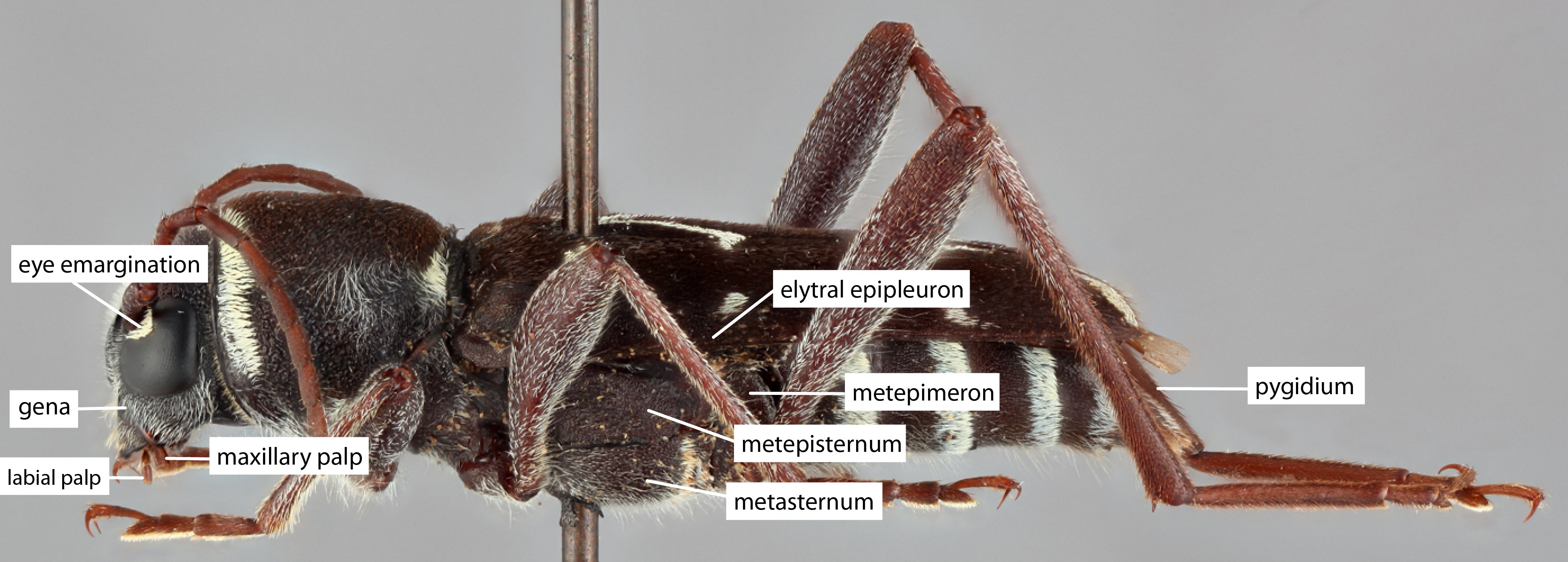 > half width or divided-max one row of facets between, eye ommatidial density fine.
> half width or divided-max one row of facets between, eye ommatidial density fine.
Antennaeantenna:
in larval and adult insects, paired segmented appendages, borne one on each side of the head, functioning as sense organs and bearing a large number of sensilla
: antennal length reaches between basebase:
the part of any appendage or structure that is nearest the body
and end of elytraelytron:
the leathery forewing of beetles, serving as a covering for the hind wings, commonly meeting opposite elytron in a straight line down the middle of the dorsum in repose
or reaching/surpassing end of body, antennal flagellar segments elongateelongate:
much longer than wide
, scapescape:
the first proximal segment of the antenna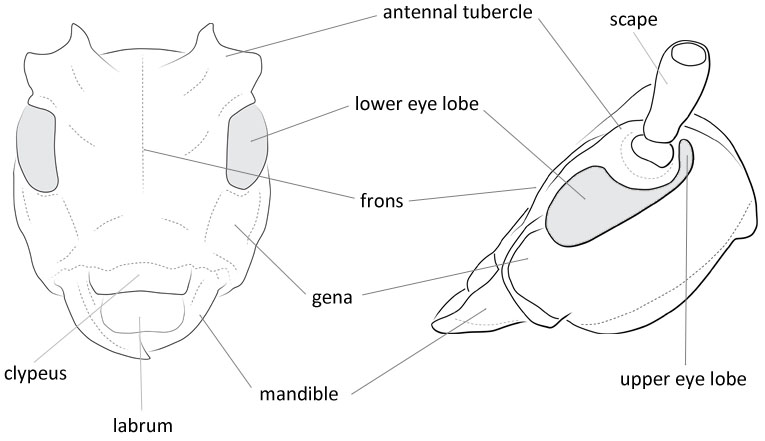 cicatrix (scar) at apexapex:
cicatrix (scar) at apexapex:
end of any structure distad to the base
, antennal segment 3 > scapescape:
the first proximal segment of the antenna .
.
Pronotumpronotum:
the upper and dorsal part of the prothorax
: pronotumpronotum:
the upper and dorsal part of the prothorax
shape transversetransverse:
broader than long
, pronotumpronotum:
the upper and dorsal part of the prothorax
lateral armature absent or blunt tubercule.
Prosternum: prosternal processprosternal process:
a posterior extension of the prosternum between the coxae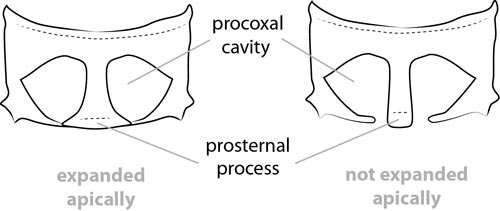 dilated at apexapex:
dilated at apexapex:
end of any structure distad to the base
, procoxal cavities closed posteriorly.
Elytraelytron:
the leathery forewing of beetles, serving as a covering for the hind wings, commonly meeting opposite elytron in a straight line down the middle of the dorsum in repose
: elytral length reaching or close to end of abdomen, elytral apicesapex:
end of any structure distad to the base
rounded or truncatetruncate:
cut off squarely at the tip
, elytral color pattern present.
Legs: visible tarsomerestarsomere:
subdivision or article of the tarsus, usually numbering from two to five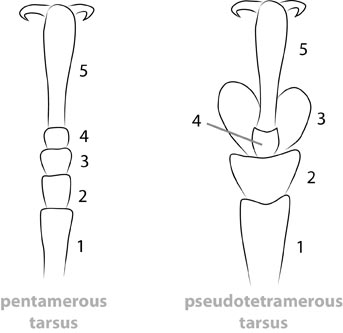 : 4, femora clavateclavate:
: 4, femora clavateclavate:
thickening gradually toward the tip
, rarely robust, protibial spursprotibial spur:
sclerotized spine(s) located at the distal tibia; can be single, double, or absent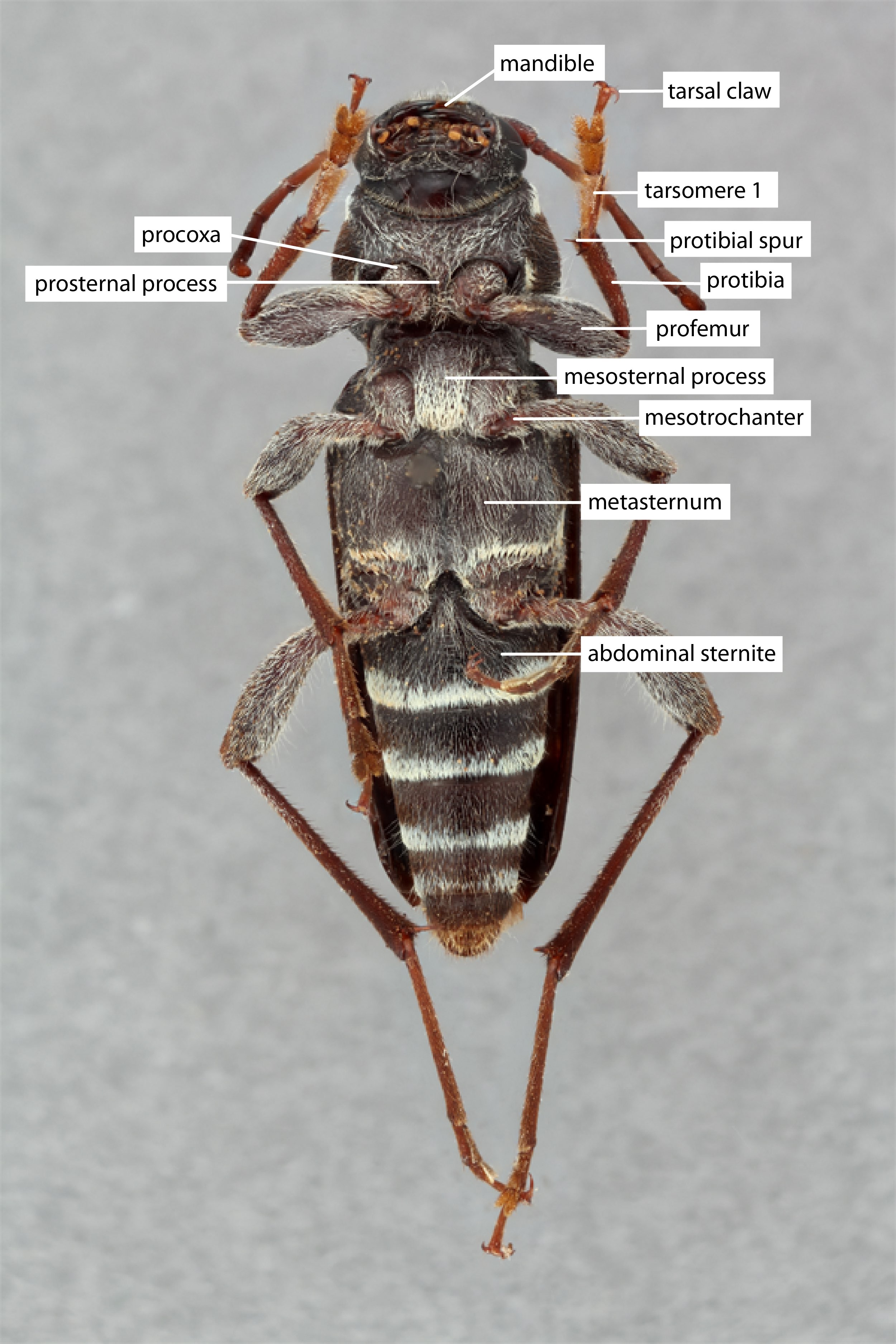 : 2, tarsal clawstarsal claw:
: 2, tarsal clawstarsal claw:
usually paired claws of the pretarsus, at the distal end of the leg simple.
simple.
Characterized by comparatively short, broad body. Head short, not narrower than pronotumpronotum:
the upper and dorsal part of the prothorax
, with produced antennal tubercleantennal tubercle:
the protuberance on the head where the antenna arises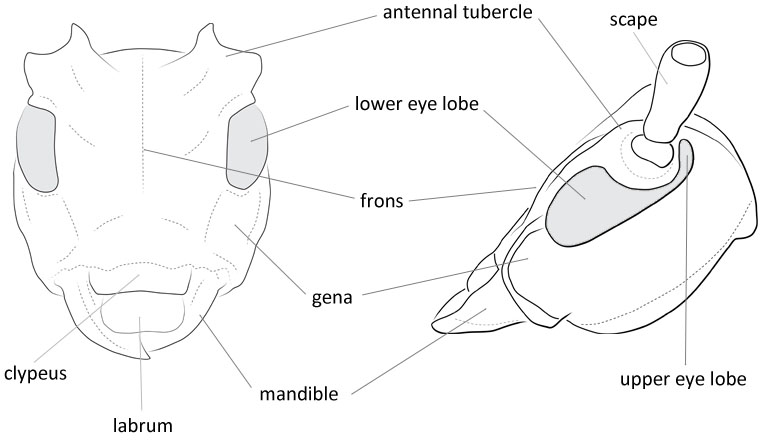 , frontally with broad median longitudinal groove. Eyes highly emarginateemarginate:
, frontally with broad median longitudinal groove. Eyes highly emarginateemarginate:
notched at the margin , divided almost into two equal lobes, lower lobelobe:
, divided almost into two equal lobes, lower lobelobe:
a rounded projection or protuberence
slightly larger than upper. Antennaeantenna:
in larval and adult insects, paired segmented appendages, borne one on each side of the head, functioning as sense organs and bearing a large number of sensilla
markedly longer than body (male) or barely extending beyond apexapex:
end of any structure distad to the base
of elytraelytron:
the leathery forewing of beetles, serving as a covering for the hind wings, commonly meeting opposite elytron in a straight line down the middle of the dorsum in repose
, on inner lower side with long dense bristles. Pronotumpronotum:
the upper and dorsal part of the prothorax
transversetransverse:
broader than long
, parallel-sided, narrower than elytraelytron:
the leathery forewing of beetles, serving as a covering for the hind wings, commonly meeting opposite elytron in a straight line down the middle of the dorsum in repose
, basally and apically without sharp flange. Elytraelytron:
the leathery forewing of beetles, serving as a covering for the hind wings, commonly meeting opposite elytron in a straight line down the middle of the dorsum in repose
short, broad, apically jointly rounded, in anterior third with coarse, simple or granular (M. curculionoides (L.)) punctationpunctation:
pits or depression of variable size in cuticle
. Legs not long, almost uniformly developed, femora sufficiently thickened. Sternite V uniformly, not highly, convex, with median longitudinal troughlike groove (female) or without it (male) (Cherepanov 1990Cherepanov 1990:
Cherepanov AI. 1990. Cerambycidae of Northern Asia, Vol. 3. Lamiinae, Part I. Oxonian Press, New Delhi 4: i–xiii + 1–300, 120 figs.).
Large and robust insects. Antennaeantenna:
in larval and adult insects, paired segmented appendages, borne one on each side of the head, functioning as sense organs and bearing a large number of sensilla
largely exceeding the apexapex:
end of any structure distad to the base
of the elytraelytron:
the leathery forewing of beetles, serving as a covering for the hind wings, commonly meeting opposite elytron in a straight line down the middle of the dorsum in repose
in the male, reaching it in the female; article 1 with a sharp, oblique rim on the outer side of the apexapex:
end of any structure distad to the base
; article III longer than IV. Eyes very strongly indented. Pronotumpronotum:
the upper and dorsal part of the prothorax
transversetransverse:
broader than long
, weakly narrowed in front, not bearing a lateral spinespine:
a protuberance with an acute (sharp) distal end
. Elytraelytron:
the leathery forewing of beetles, serving as a covering for the hind wings, commonly meeting opposite elytron in a straight line down the middle of the dorsum in repose
rounded at the apexapex:
end of any structure distad to the base
(Villiers 1946Villiers 1946:
Villiers A. 1946. Coléoptères Cérambycides de l'Afrique du Nord. Faune de l'Empire Français, ORSC Paris 5: 1–152, 275 figs. http://www.cerambycoidea.com/titles/villiers1946.pdf). Triangular shaped scapescape:
the first proximal segment of the antenna .
.
Coptops, Mnemia, Japanomesosa, Eurymesosa, many Mesosini
The enlarged apical scapescape:
the first proximal segment of the antenna of this genus (and tribe) gives it a triangular shape that is unique. The squat body form of the tribe is also consistent. Within Mesosini, Mesosa has no spines on the antennomeresantennomere:
of this genus (and tribe) gives it a triangular shape that is unique. The squat body form of the tribe is also consistent. Within Mesosini, Mesosa has no spines on the antennomeresantennomere:
a subunit of the antenna, including the scape, pedicel, and flagellomeres
, the third antennomereantennomere:
a subunit of the antenna, including the scape, pedicel, and flagellomeres
obviously longer than the scapescape:
the first proximal segment of the antenna , unarmed elytral apicesapex:
, unarmed elytral apicesapex:
end of any structure distad to the base
, and the eyes are almost completely divided.
Palearctic, Indomalaya
broadleaf; Abies, Larix, Pinus, Tsuga; Chamaecyparis
7 spp. (Mesosa), 30 spp. (Aplocnemia), 2 spp. (Lissomesosa), 4 spp. (Metamesosa), 18 spp. (Perimesosa), 32 spp. (Saimia). Conifers: M. (Mesosa) japonica, M. (M.) mediofasciata, M. (Lissomesosa) kirisimana (Pinus), Mesosa (Metamesosa) nomurai (Abies, Pinus), Mesosa (Perimesosa) hirsuta (Abies, Pinus, broadleaf).
Dendrobius, Gistel, 1834 [for Mesosa]
Lamia (Mesosa) Brullé, 1832 [for Mesosa]
Haplocnemia Agassiz, 1846 [for Aplocnemia]
Helixoea Pascoe, 1865 [for Aplocnemia]
Subgenus Mesosa, Latreille, 1829
Subgenus Aplocnemia, Stephens, 1831
Subgenus Lissomesosa, Yamasako and Ohbayashi, 2011
Subgenus Metamesosa, Breuning, 1938
Subgenus Perimesosa, Breuning, 1939
Subgenus Saimia, Pascoe, 1866